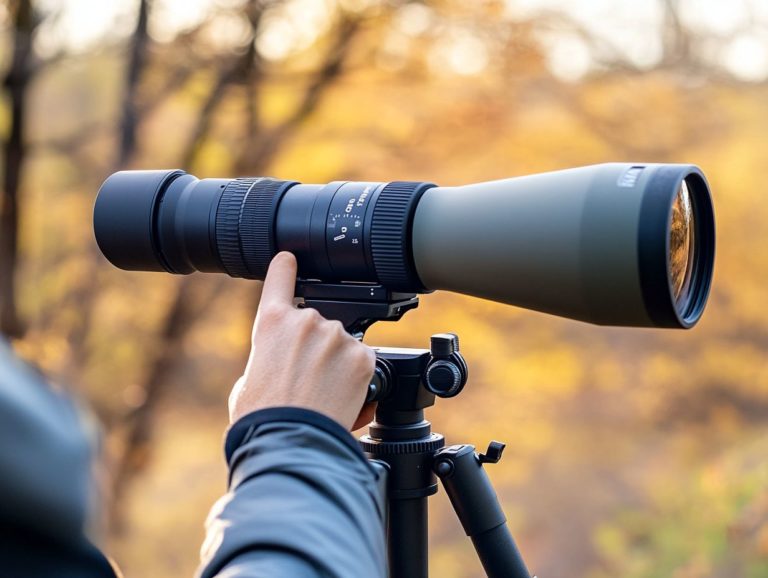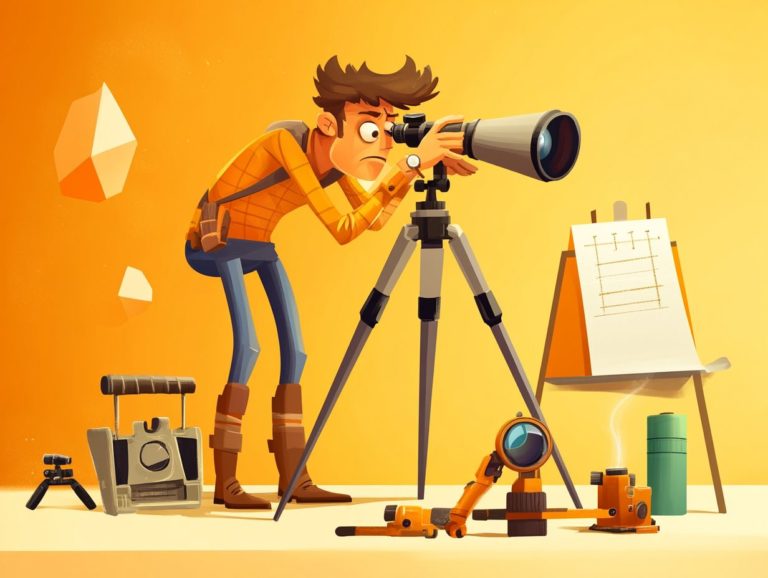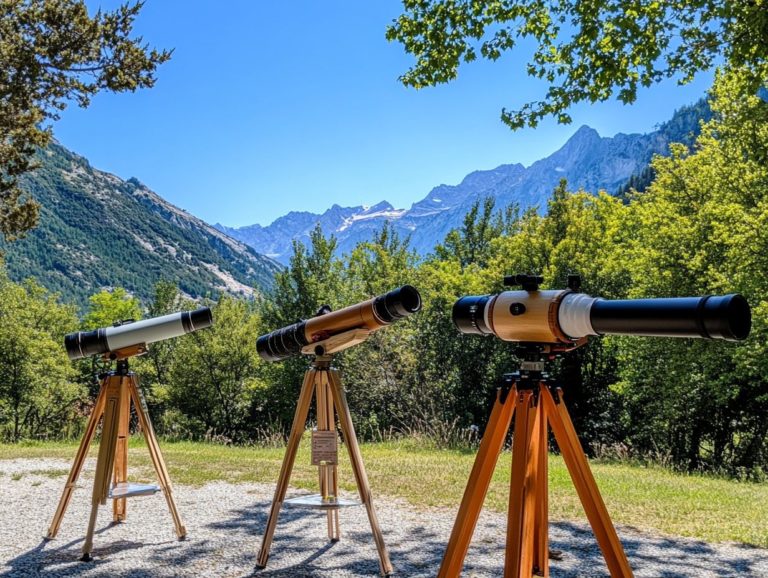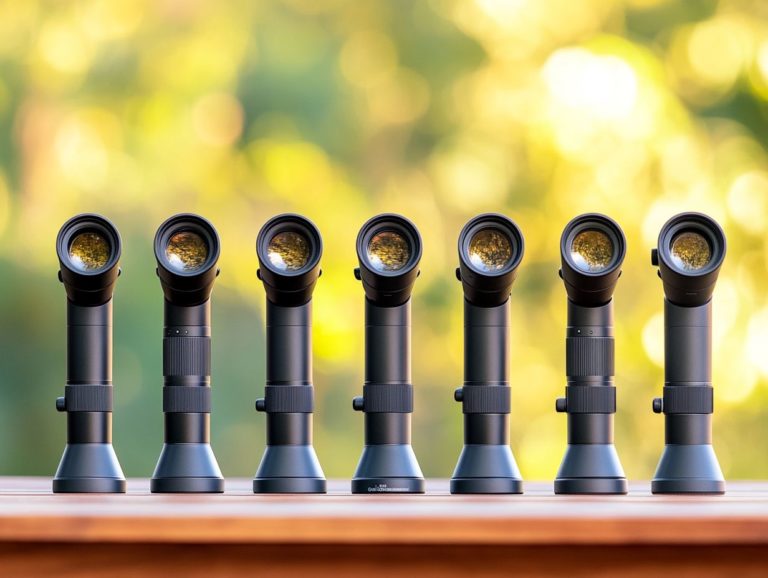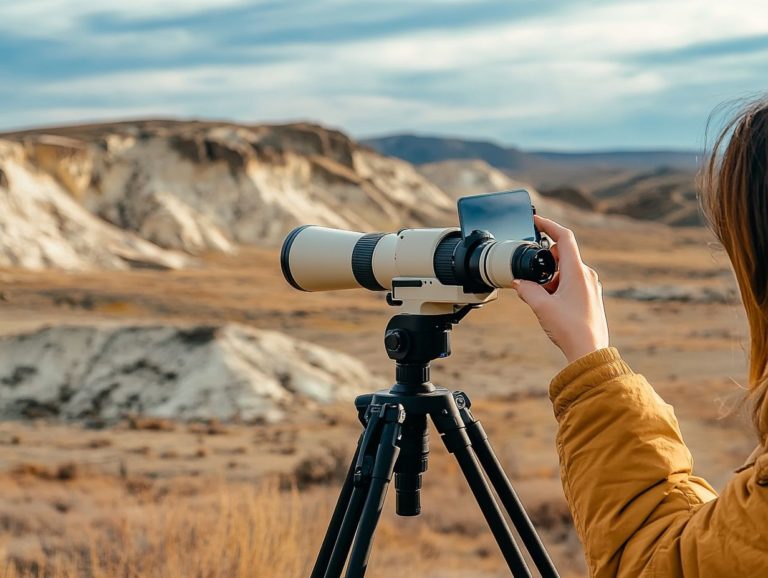Spotting Scope Selection: Factors to Consider
Are you eager to elevate your outdoor adventures? Birdwatching, hunting, or stargazing can all benefit from a spotting scope as your ideal companion!
This guide offers insights to help you select the perfect scope. You will explore key factors like magnification, lens size, and image clarity.
You will also discover essential accessories to boost your viewing experience. Get ready to make a well-informed choice that suits your needs!
- Key Takeaways:
- Factors to Consider When Choosing a Spotting Scope
- Types of Spotting Scopes
- accessories for spotting scopes
- frequently asked questions
- What is a spotting scope and why do I need one?
- What are the main factors to consider when selecting a spotting scope?
- How does magnification power affect a spotting scope’s performance?
- What is the significance of lens diameter in a spotting scope?
- What is the difference between a porro prism and a roof prism in spotting scopes?
- What should I look for in terms of durability when selecting a spotting scope?
Magnification and objective lens size are crucial factors when choosing a spotting scope, as they affect the clarity and viewing distance of the image.
- Consider the type of spotting scope – straight or angled, compact or full-size, and the type of glass used – ED or non-ED, based on your specific needs and preferences.
- Investing in accessories such as tripods, mounts, and weatherproofing can greatly enhance the functionality and durability of your spotting scope.
Contents
Key Takeaways:
What is a Spotting Scope?
A spotting scope is your ultimate tool for outdoor adventures, especially for birdwatchers and wildlife enthusiasts. It provides exceptional image clarity and impressive magnification.
This powerful viewing tool features a larger objective lens that enhances light gathering and overall optical performance, making it perfect for long-distance viewing.
Those high-quality lens coatings? They re essential for reducing glare and boosting clarity! The eyepiece placement can be tailored to fit your experience. Whether you’re wandering through the Great Smoky Mountains or diving into digiscoping photography (using a spotting scope for photography), a spotting scope offers an unparalleled way to immerse yourself in nature.
Constructed from robust materials to endure outdoor challenges, these scopes often boast waterproof and fog-proof features, ensuring reliability in any weather. Their versatility allows easy switching between different magnification levels, often surpassing what binoculars can deliver.
Plus, the compact yet sturdy design makes portability a breeze, which is a significant advantage on those lengthy treks. This optical gem offers superior quality, allowing you to catch remarkable details at impressive distances, making it a coveted tool among photographers and nature observers alike.
In essence, a spotting scope merges ergonomics, durability, and advanced optics to elevate your outdoor exploration experience!
Factors to Consider When Choosing a Spotting Scope
Choosing the right spotting scope requires careful thought about several key factors. Start with magnification power, which determines how far you can see, and consider the top features to look for in a spotting scope.
Next, consider the size of the objective lens; this significantly impacts light gathering capabilities and overall image quality. Don t overlook eyepiece placement, as it plays a vital role in ensuring comfortable viewing during those long sessions in the field.
Weight and portability are also essential for your outdoor escapades, allowing you to carry your gear without breaking a sweat. Finally, keep your budget in mind, as it will greatly shape your equipment choices. With the right scope, you’ll elevate your outdoor experience to new heights!
Magnification and Zoom
Get ready to dive into the world of magnification, where every detail comes to life! When selecting a spotting scope, paying attention to magnification and zoom capabilities is essential. These features greatly influence how effectively you can observe distant subjects, such as birds or wildlife.
Different magnification levels can dramatically enhance your viewing experience. For example, a scope with a 20-60x zoom offers a broad spectrum of detail, allowing you to appreciate the nuances of your subject. Zoom lenses work by adjusting the focal length, enabling you to transition seamlessly from sweeping landscapes to finely detailed close-ups of elusive creatures.
However, while higher magnifications might seem appealing, they can sometimes compromise image quality, particularly in low-light conditions.
Popular models like the Vortex Diamondback and the Celestron Regal series are tailored for both wildlife viewing and birding enthusiasts. These scopes offer a variety of magnification options to cater to both beginners and seasoned observationalists alike, ensuring that you find the perfect fit for your outdoor adventures.
Objective Lens Size
The size of the objective lens in your spotting scope is crucial for determining its ability to collect light, which directly impacts image clarity and detail.
While a 50mm lens might get the job done during the day, you may find it lacking as light fades. On the other hand, an 80mm objective lens can significantly enhance your visibility in low-light conditions, allowing you to observe wildlife more effectively at dawn or dusk.
This increase in light capture gives you brighter and clearer images that elevate the overall detail and sharpness of your experience. Many wildlife watchers have noted that larger lenses not only minimize glare but also amplify contrast, making it easier to spot those elusive creatures as the light fades.
Choose the right lens size now to elevate your outdoor adventures don’t miss out on the beauty around you!
Field of View
The field of view (FOV) is a key feature of spotting scopes that determines how wide the observable area is at a specific distance. For bird watchers and outdoor enthusiasts like yourself, the FOV is vital for effectively observing and engaging with wildlife.
A wider FOV enhances your tracking experience, especially when you’re following fast-moving subjects, such as birds in flight or animals weaving through thick brush. This broader perspective not only simplifies the task of locating and identifying various species but also elevates your overall enjoyment of the outdoor experience.
With a generous FOV, you can make swift adjustments without losing visual contact, ensuring you don t miss those fleeting moments nature has to offer.
Image Quality and Clarity
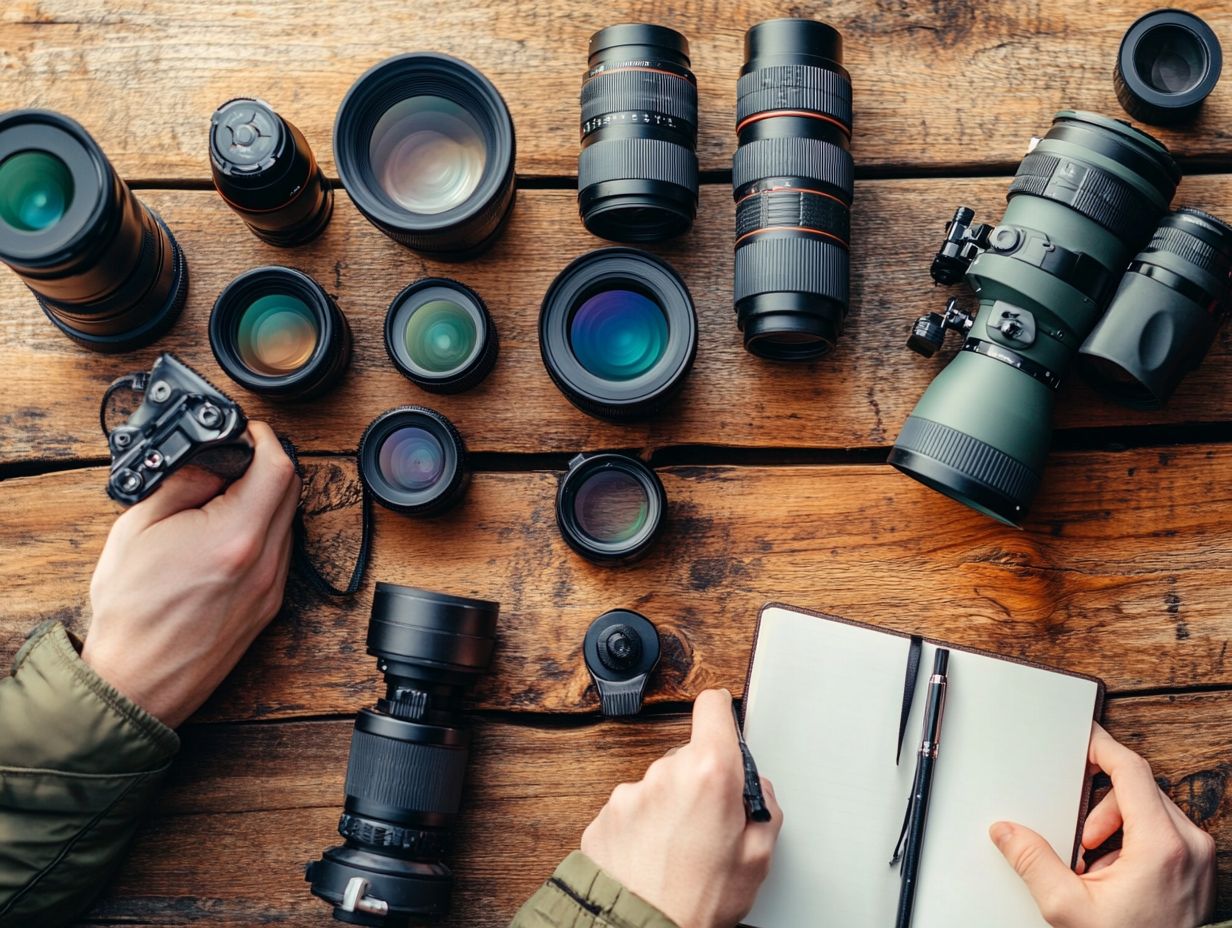
Image quality and clarity are absolutely essential when you evaluate a spotting scope, as these factors directly influence your ability to appreciate the intricate details of wildlife and landscapes.
Several key elements contribute to that coveted clarity, with high-quality lens coatings being vital in reducing glare and enhancing light transmission. Optics that feature superior lens material not only guarantee sharp images but also bolster overall durability, making them essential for use in any weather.
When you compare these scopes to binoculars, it quickly becomes clear that while binoculars may suffice for casual observation, serious bird watchers and photographers often seek the unwavering quality offered by premium optics.
The intricate design and engineering behind high-quality spotting scopes ensure that you can truly immerse yourself in the breathtaking details of the natural world.
Weight and Portability
The weight and portability of a spotting scope are important factors for your outdoor adventures. These elements directly influence how easily you can transport and set up your equipment in various environments.
When you re gearing up for a hiking trip, choose a model with a lightweight design. This can greatly elevate your overall experience.
A compact and lightweight scope minimizes fatigue during long treks and allows for swift setup when nature s wonders call out to you.
Make sure your scope is compatible with a reliable tripod system. This will stabilize your scope and let you enjoy crisp, clear views without the annoyance of shaky hands or uneven terrain. Stable views are key for spotting distant wildlife and enhancing your adventure!
Price and Budget
Setting a budget for your spotting scope is essential, especially since prices can fluctuate significantly based on features, magnification power, and the credibility of trusted brands.
To identify the best spotting scopes across different price points, you’ll want to strike a balance between quality optics and affordability. It’s prudent to explore options from reputable manufacturers, along with spotting scope use tips for beginners that can help you make informed choices.
- Nikon, renowned for its reliable clarity,
- Celestron, which offers outstanding entry-level models,
- Vortex, celebrated for its sturdy design and impressive performance.
Each brand brings its own unique strengths and features to the table, enabling you to make informed choices that align with both your viewing preferences and financial considerations.
By meticulously comparing specifications and reviews, you can uncover models that provide exceptional value without compromising on quality.
Types of Spotting Scopes
Grasping the different types of spotting scopes is crucial for making a well-informed purchase. To ensure you select the perfect tool for your needs, consider what to consider when buying a used spotting scope, as each design is tailored to specific viewing preferences and applications.
Straight vs Angled
Your choice between straight and angled spotting scopes can greatly enhance your experience, especially if you’re a bird watcher or an outdoor enthusiast.
When deciding which design suits you best, think about your preferred viewing angles and how comfortable you’ll be during extended use.
For example, straight spotting scopes often allow for quicker target acquisition, making them ideal for tracking fast-moving wildlife. If you wear eyeglasses, you might find angled scopes more comfortable, as they put less strain on your neck during long observation sessions.
Imagine yourself perched atop a hillside as a bird watcher; an angled scope could provide you with the ergonomic benefits you crave. Conversely, if you’re a hunter in an open field, the straightforward nature of a straight scope might be more appealing.
Ultimately, your personal preference, intended use, and physical comfort are essential elements that will guide your decision between these two designs.
Compact vs Full-size
Choosing between compact and full-size spotting scopes boils down to your need for portability versus optical performance on your outdoor adventures.
If you frequently hike or travel, compact models from brands like Vortex or Leupold can seamlessly fit into your backpack, ensuring you stay mobile without compromising too much on image quality.
These smaller scopes shine when weight is a factor, making them perfect for pursuits like birdwatching or wildlife photography, where quick setup can make all the difference.
However, while the convenience of compact scopes is undeniable, full-size options from brands like Swarovski or Nikon often provide exceptional clarity and detail essential for serious observation or long-distance spotting.
The balance between ease of transport and superior optics is a crucial consideration for any outdoor enthusiast like yourself.
ed vs non-ed glass
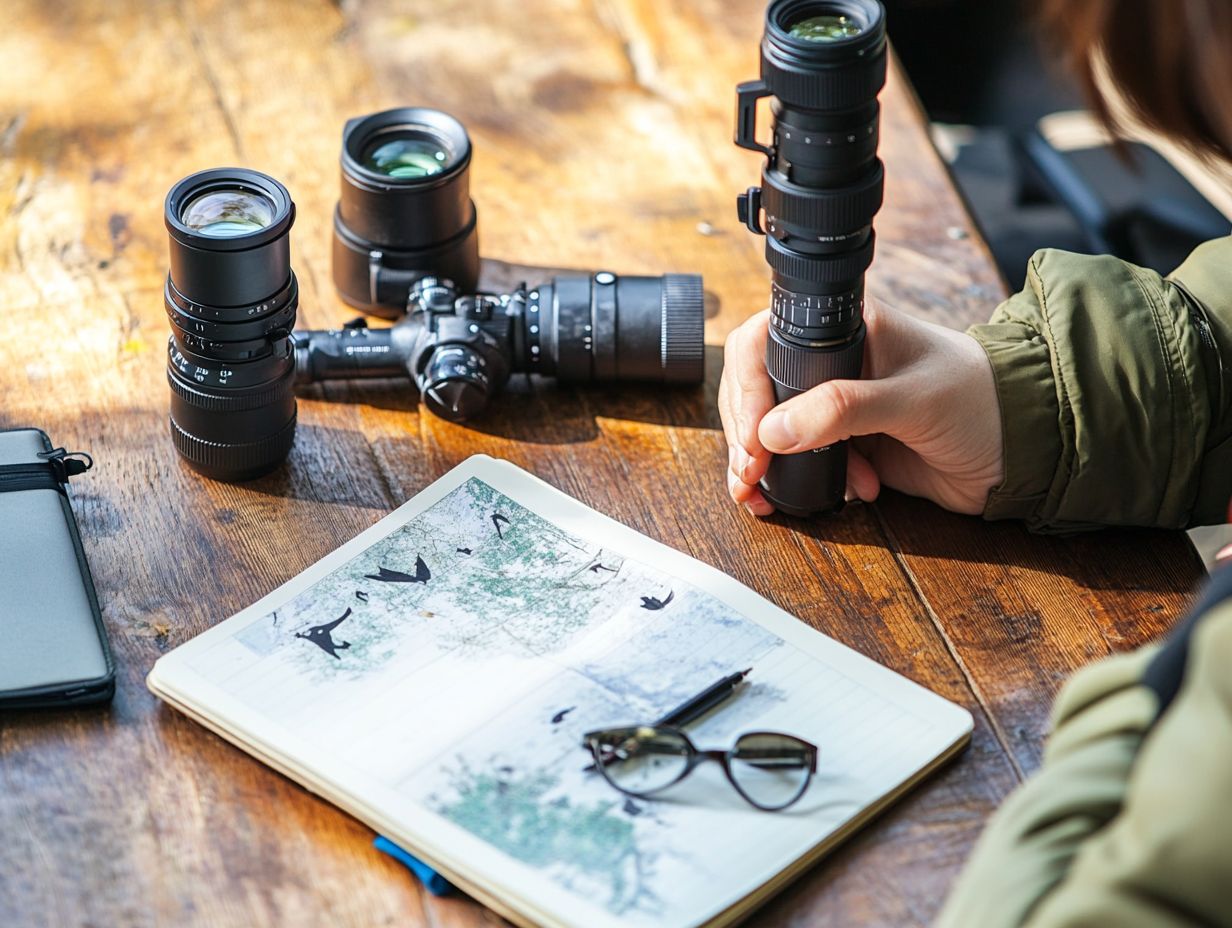
The distinction between ed (extra-low dispersion) glass and non-ed glass in spotting scopes has a direct impact on optical quality and image clarity.
When you peer through a high-quality optic like a spotting scope, the differences between these two types of glass become strikingly evident. Ed glass is carefully designed to minimize color distortion, which can lead to distorted colors. As a result, you will find that colors appear more vibrant and true-to-life, significantly enhancing your overall viewing experience.
In contrast, non-ed glass can result in a blurry view. This muddles details and compromises sharpness. With ed glass, however, you enjoy superior contrast and detailed definition, allowing for a more immersive connection with nature, wildlife, or your favorite sporting events.
accessories for spotting scopes
Enhancing your spotting scope experience often means choosing the right accessories, as they can greatly elevate both functionality and performance.
tripods and mounts
Using a tripod or mount with your spotting scope is essential for achieving that coveted stability and enhancing your overall experience, especially when observing distant wildlife.
A well-secured scope minimizes vibrations, allowing you to enjoy extended viewing periods without the burden of fatigue. You can select from a variety of tripods whether you prefer lightweight options for easy transport or more robust models built for rugged terrains tailoring your choice to suit your specific outdoor adventures.
Specialized mounts provide versatility, accommodating different spotting scopes and ensuring stability even on uneven ground. This adaptability is vital for birdwatchers, hunters, and nature enthusiasts who depend on precision for optimal observation.
Investing in the right support gear can greatly improve your performance, making every outdoor excursion not just enjoyable but also immensely productive.
camera adapters
Camera adapters are critical accessories for your spotting scope, allowing you to capture breathtaking photographs through the lens while indulging in the art of digiscoping. Digiscoping is the practice of using a spotting scope to take photos with a camera.
These devices act as a vital link between your camera and the spotting scope, simplifying the process of achieving exceptional optical performance. You’ll find various types of adapters available, each meticulously designed to fit specific models of scopes, ensuring a flawless connection. Whether you re wielding a compact point-and-shoot or a top-tier dslr, the right adapter can elevate your photography experience to new heights.
By providing stable connections and enabling precise alignment, these adapters not only enhance image quality but also enable you to delve into the intricate details of wildlife and landscapes, enriching your entire digiscoping adventure.
weatherproofing and durability
When selecting a spotting scope, it’s essential to prioritize weatherproofing and durability, especially for your outdoor adventures in diverse conditions. For more insights, check out our guide on understanding spotting scope specifications.
Opting for a model that features both waterproof and fogproof capabilities can significantly elevate your experience as a wildlife enthusiast. These attributes ensure that your scope remains functional even in challenging weather, safeguarding its internal components from moisture and debris that might accumulate during your hikes or birdwatching excursions.
By investing in equipment with these resilient qualities, you can count on seamless viewing, enhancing your connection with nature. Ultimately, the reliability provided by such robust designs highlights their importance in making well-informed choices about your outdoor gear.
frequently asked questions
What is a spotting scope and why do I need one?
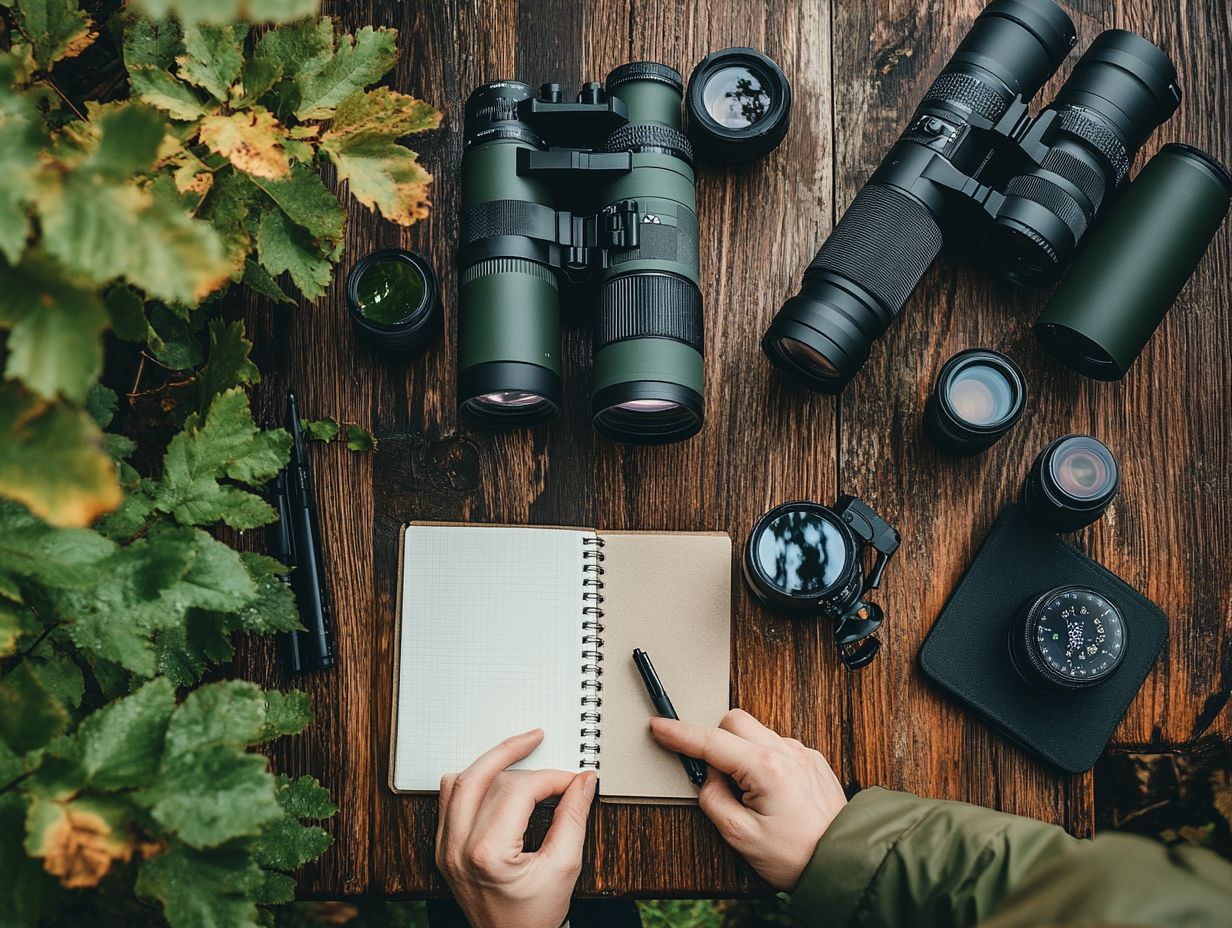
Are you ready for an adventure? A spotting scope is your portable telescope for amazing views of wildlife and landscapes. It offers a much closer and clearer view of distant objects compared to regular binoculars.
If you enjoy outdoor activities that involve viewing distant objects, a spotting scope is a great tool to have.
What are the main factors to consider when selecting a spotting scope?
There are several factors to consider when choosing a spotting scope. These include magnification power, lens diameter, field of view, the design of the internal components that help focus the image, and durability.
Evaluate your specific needs to choose the right features for your use.
How does magnification power affect a spotting scope’s performance?
The magnification power determines how much closer the object will appear compared to the naked eye. Higher magnification can be useful for long-range viewing.
However, it can also decrease the field of view and make the image shakier. Balance magnification with other factors for optimal performance.
What is the significance of lens diameter in a spotting scope?
The lens diameter, measured in millimeters, determines how much light can enter the scope. A larger lens diameter allows for better light gathering, resulting in a brighter and clearer image.
Keep in mind that a larger lens also means a heavier and more expensive scope. Consider your specific needs when choosing the right diameter.
What is the difference between a porro prism and a roof prism in spotting scopes?
Porro and roof prisms are the two main types of prisms used in spotting scopes. Porro prisms offer better light transmission and a wider field of view.
However, they tend to be bulkier and less durable than roof prisms. Roof prisms, on the other hand, are more compact and lightweight, making them a popular choice for outdoor activities.
What should I look for in terms of durability when selecting a spotting scope?
Durability is crucial, especially if you plan on using your spotting scope in rugged outdoor environments. Look for scopes with waterproof and fog-proof features.
Don t forget to grab a protective carrying case your spotting scope deserves the best care!

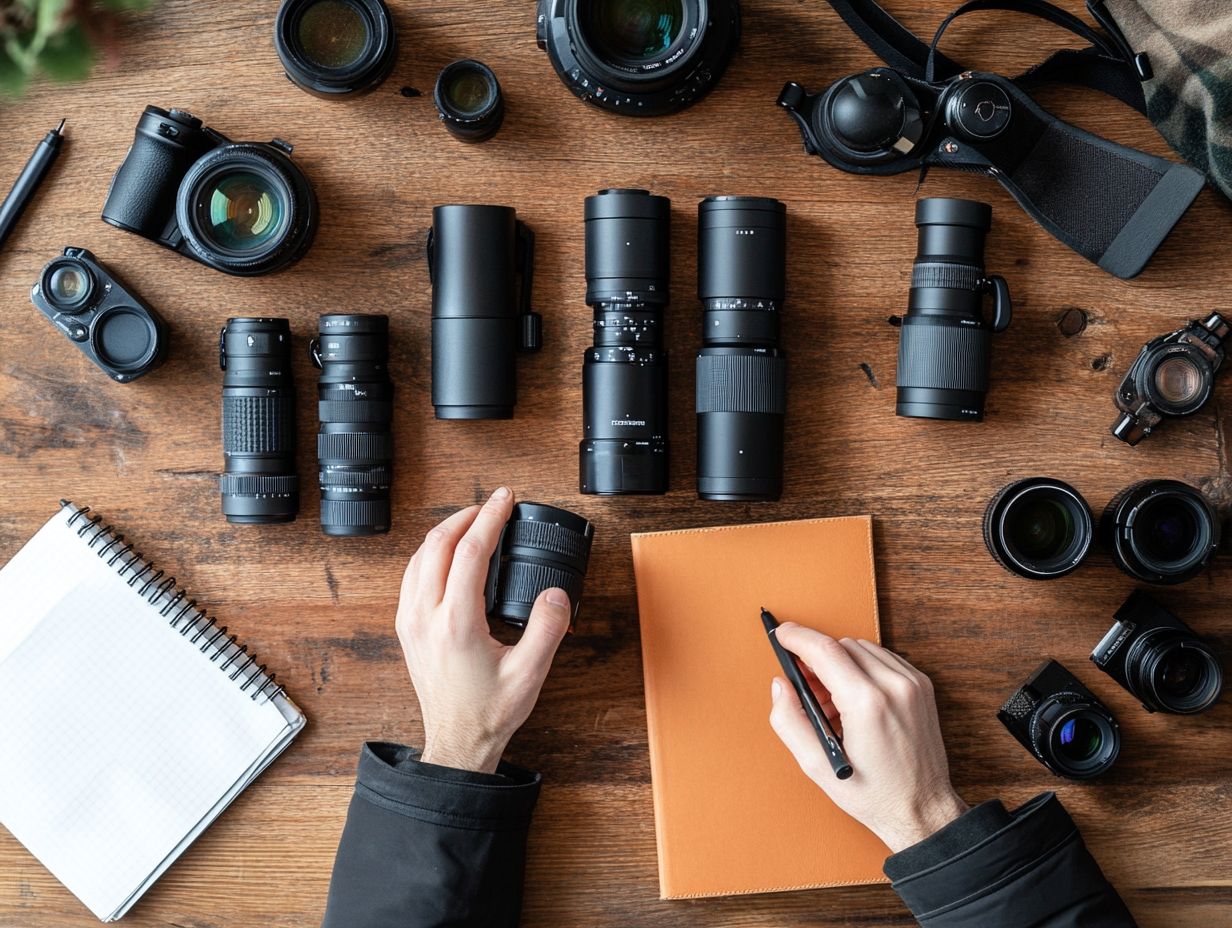 Magnification and objective lens size are crucial factors when choosing a spotting scope, as they affect the clarity and viewing distance of the image.
Magnification and objective lens size are crucial factors when choosing a spotting scope, as they affect the clarity and viewing distance of the image.
